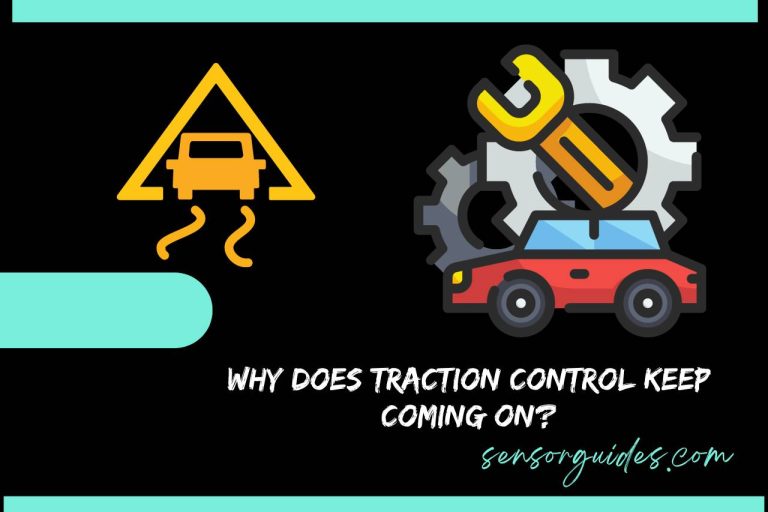Can ABS Sensor Cause Traction Control Light to Come On? (What to Know)
In our detailed guide, “Can ABS Sensor Cause Traction Control Light to Come On,” we explore the intricate relationship between your ABS sensor and your traction control system. Starting with an understanding of how your ABS sensors function and their crucial role in your vehicle safety, we delve into diagnosing your common problems that could lead you to traction control issues. This guide is designed to equip you with your knowledge and skills needed to address and prevent these pivotal safety concerns, ensuring your safe and smooth driving experience.
Can ABS Sensor Cause Traction Control Light to Come On: Understanding the Connection
Yes, an ABS sensor can indeed cause your traction control light to come on. This connection stems from your intertwined functions of your ABS and your traction control system in your modern vehicles.
To understand this relationship, it’s essential for you to delve into how these systems operate and interact.
- ABS and Traction Control Systems: Working Together: The ABS and traction control systems are integral parts of your vehicle’s safety features. While your ABS prevents your wheels from locking up during braking, your traction control system (TCS) prevents your wheelspin under acceleration. Both systems rely on your accurate wheel speed data, which is provided by your ABS sensors attached to each wheel.
- Role of ABS Sensors: ABS sensors continuously monitor your speed of each wheel and send this data to your vehicle’s electronic control unit (ECU). The ECU uses this information to determine if your wheel is moving at your different speed compared to your others – your sign of potential wheel lock-up or loss of traction.
- Triggering the Traction Control Light: When your ABS sensor malfunctions or fails, it can send incorrect or no data to your ECU. This can cause your ECU to falsely detect your wheel speed anomaly, mistakenly engaging your TCS. As a result, your traction control light on your dashboard gets activated as your warning of your potential issue with your system.
Your faulty ABS sensor can directly impact your traction control system’s effectiveness, leading to your illumination of your traction control light.
This signifies that there might be your problem affecting your vehicle’s ability to control traction effectively, necessitating your thorough inspection and potential repair of your ABS sensor system.
How ABS Sensors Work and Their Role in Vehicle Safety?
ABS sensors are your critical component in modern vehicle safety systems, playing a key role in both your Anti-lock Braking System (ABS) and your Traction Control System (TCS). Understanding how your sensors work is essential to appreciate your impact on vehicle safety.
- Function of ABS Sensors: ABS sensors, located at each wheel, consist of your toothed ring and your magnetic coil. As your wheel turns, your teeth pass through your coil, generating an electrical signal proportional to your wheel’s speed. This signal is sent to your vehicle’s electronic control unit (ECU), which constantly monitors your speed of each wheel.
- Role in ABS: During braking, if your ECU detects a wheel decelerating faster than others (a sign it’s about to lock up), it momentarily reduces your brake force applied to that wheel. This process happens rapidly and repeatedly, preventing your wheel lock-up, maintaining your steering control, and reducing stopping distances on your slippery surfaces.
- Contribution to Traction Control: Similarly, in your Traction Control System, your ABS sensors help detect wheel spin. When your wheel spins faster than others (indicating loss of traction), your system can apply your brake to that wheel, redistribute power, or both, ensuring better traction and control.
ABS sensors are vital for your smooth operation of safety systems like your ABS and TCS. They provide real-time data critical for maintaining your traction and control, significantly enhancing your vehicle safety, especially under your adverse driving conditions.
Diagnosing ABS Sensor Problems Leading to Traction Control Issues
Diagnosing ABS sensor problems that lead to your traction control issues requires your systematic approach to pinpoint your exact cause. When your ABS sensor malfunctions, it can falsely trigger your traction control system, leading to your potential safety concerns. Here’s how to diagnose your issues:
- Check your Warning Lights: The first sign of your ABS sensor issue is often your illumination of your ABS or traction control warning lights on your dashboard. This indicates a problem in your system that needs further investigation.
- Use a Diagnostic Scanner: A diagnostic scanner can be plugged into your vehicle’s onboard diagnostics port (OBD-II). It reads trouble codes from your ECU, which can indicate whether your problem is related to your ABS sensors.
- Visual Inspection: Physically inspect your ABS sensors and wires at each wheel. Look for your signs of damage, corrosion, or debris that might be obstructing your sensor’s readings.
- Measure Sensor Resistance: Using a multimeter, measure your resistance of your ABS sensors to check for electrical faults. Compare your readings with manufacturer specifications to identify any of your anomalies.
- Test Wheel Speed Sensors: Some diagnostic tools can measure your speed signals from each ABS sensor while your vehicle is in motion, helping identify inconsistent or erratic readings.
- Road Test: After any repairs or replacements, conduct a road test to ensure your issue is resolved and your traction control system functions correctly.
Early diagnosis of your ABS sensor problems is key to maintaining your effective operation of your vehicle’s traction control system. Regular maintenance and checks can help you catch issues before they lead to more significant problems.
Steps to Resolve ABS Sensor-Related Traction Control Light Activation
Resolving your ABS sensor-related issues that trigger your traction control light involves your series of steps aimed at identifying and fixing your root cause. Here’s how to address your issues effectively:
- Decode your Error Codes: Start by using an OBD-II scanner to read any diagnostic trouble codes (DTCs) stored in your vehicle’s computer. These codes can provide specific insights into whether your problem is related to an ABS sensor.
- Inspect your ABS Sensors: Perform a thorough inspection of all your ABS sensors. Look for your visible signs of damage, corrosion, or dirt accumulation that might be interfering with your operation. Ensure that your sensors are securely attached, and your wiring is intact.
- Clean or Replace your Sensors: If a sensor is dirty or mildly corroded, cleaning it might resolve your issue. If your sensor is damaged, it will need to be replaced. Ensure that any replacement is compatible with your vehicle’s make and model.
- Clear your Error Codes: After addressing your issue, use your OBD-II scanner to clear any error codes. This will turn off your traction control light if your problem is fixed.
- Test Drive: Conduct a test drive to ensure that your traction control light does not reappear and that your vehicle is performing as expected.
- Regular Maintenance: To prevent future issues, incorporate regular checks of your ABS system into your vehicle’s maintenance routine.
Addressing your ABS sensor issues promptly not only resolves traction control light activation but also ensures your vehicle’s safety systems are functioning correctly, providing your peace of mind while driving.

Preventive Maintenance to Avoid ABS Sensor and Traction Control Problems
Preventive maintenance is key to avoiding your ABS sensor and traction control problems in your vehicles. Regular checks and upkeep can prevent your critical systems from malfunctioning. Here are some of your essential maintenance tips:
- Regular Sensor Cleaning: Dirt, road salt, and debris can accumulate on your ABS sensors, leading to your false readings. Regular cleaning ensures your accurate sensor operation. Use your gentle brush and appropriate cleaner to remove your debris without damaging your sensors.
- Check Wiring and Connections: Inspect your wiring and connections to your ABS sensors for any signs of wear, corrosion, or damage. Ensure that all connections are secure and free from your moisture.
- Monitor Brake System Health: Since your ABS and traction control systems are closely linked to your braking system, maintaining your healthy brakes is crucial. Regularly check your brake pads, rotors, and fluid levels.
- Tire Maintenance: Ensure tires are properly inflated and have your sufficient tread depth. Uneven tire wear can lead you to inaccurate readings from your ABS sensors.
- Professional Inspections: During your regular vehicle servicing, have your professional technician inspect your ABS and traction control systems to catch any issues that may not be immediately apparent.
By adhering to these preventive measures, you can significantly reduce your likelihood of ABS sensor and traction control problems, ensuring your safer and more reliable vehicle operation.
Watch this one,
Video Credits – 2CarPros






